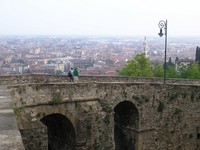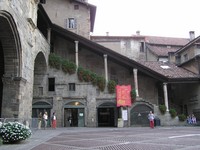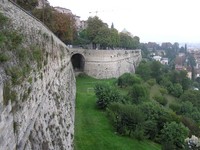Bergamo
 Bergamo is one of Italyâs lesser-known jewels, overshadowed by its bigger and brasher neighbour, Milan. Visitors to Bergamo actually get two towns for the price of one â the modern citta bassa (lower town) sits at the base of a jagged hilltop upon which the citta alta (upper town) perches. The upper town is a maze of medieval cobbled streets and shady piazzas, enclosed by Venetian walls. Soak up its rich heritage in music, art and architecture, then go and indulge your baser desires (food, drink, shopping) in the modern town below.
Bergamo is one of Italyâs lesser-known jewels, overshadowed by its bigger and brasher neighbour, Milan. Visitors to Bergamo actually get two towns for the price of one â the modern citta bassa (lower town) sits at the base of a jagged hilltop upon which the citta alta (upper town) perches. The upper town is a maze of medieval cobbled streets and shady piazzas, enclosed by Venetian walls. Soak up its rich heritage in music, art and architecture, then go and indulge your baser desires (food, drink, shopping) in the modern town below.
Attractions
 Most tourist attractions are in the citta alta â visitors tend to park down below and ride the funicular railway up to the top. The energetic can just as easily walk up the steep streets, and will be rewarded with the experience of crossing the part-bridge part-viaduct which leads you into the citta; a perfect place from which to look down on the sprawling citta bassa you have left behind. The thick solid walls, which you can walk along in places, are the handiwork of the Venetians who controlled the town until 1797.
Most tourist attractions are in the citta alta â visitors tend to park down below and ride the funicular railway up to the top. The energetic can just as easily walk up the steep streets, and will be rewarded with the experience of crossing the part-bridge part-viaduct which leads you into the citta; a perfect place from which to look down on the sprawling citta bassa you have left behind. The thick solid walls, which you can walk along in places, are the handiwork of the Venetians who controlled the town until 1797.
Centre of the citta alta is the large Piazza Vecchia, framed on its northern side by a porticoed palazzo of white marble, which now serves as the public library. Opposite are the columns, arches and covered staircases of the 12th Palazzo della Ragione. The Torre del Campanone (bell tower) soars above, and those with a head for heights can climb it for tremendous views over the labyrinthine streets below. At the piazzaâs centre a fountain adorned with stone lions (symbols of Venice) entertains the children whilst parents sip coffees at the outdoor cafes.
 Tucked behind is the Piazza del Duomo, where most places of worship are gathered. The baroque Duomo is outclassed by the Basilica di Santa Maria Maggiore next door. This Romanesque church was begun in 1137 and holds a wealth of artisanship. As well as the frescoes and tapestries, make sure to look at the biblical scenes inlayed into the wooden choir stalls; artists G.F. Capoferri and G. Belli used different woods as well as herbal infusions and hot sand to create the sensitive colour variation. Adjacent to the Basilica is the glitzy marble Cappella Colleoni.
Tucked behind is the Piazza del Duomo, where most places of worship are gathered. The baroque Duomo is outclassed by the Basilica di Santa Maria Maggiore next door. This Romanesque church was begun in 1137 and holds a wealth of artisanship. As well as the frescoes and tapestries, make sure to look at the biblical scenes inlayed into the wooden choir stalls; artists G.F. Capoferri and G. Belli used different woods as well as herbal infusions and hot sand to create the sensitive colour variation. Adjacent to the Basilica is the glitzy marble Cappella Colleoni.
The fortified citadel sits at the upper townâs western tip. It holds two museums. Try the Museo di Scienze Naturali Enrico Caffi if youâre a fan of fossils and stuffed animals, or the Civico Museo Archeologico for a taste of Bergamoâs early history, with prehistoric and roman artefacts.
 If youâre not worn out by now, find the Colle Aperto and climb the stone steps to reach the Orti Botanico Lorenza Rota, a spectacular garden clinging to the hillside.
If youâre not worn out by now, find the Colle Aperto and climb the stone steps to reach the Orti Botanico Lorenza Rota, a spectacular garden clinging to the hillside.
Art buffs should head down to the citta bassa; the Academia Carrara holds an impressive range works by Italian masters. Raphael, Botticelli, Canaletto, Mantegna, Titian, Bellini and Carpaccio are all represented here. Opposite is a modern art gallery where you can assess the new generationâs attempts to step into those mastersâ shoes.
Shopping
Bergamo might not quite rival Milan for fashion, but it still has a good array of designer stores and smart boutiques. Indeed, you can hardly move for them in the citta bassaâs Via XX Settembre. For more mainstream shopping, you wonât find a better venue than the Orio Center, Italyâs biggest shopping centre. Its 200 shops sell almost anything you could possibly want. There are also restaurants, bars, a supermarket, a nursery and an underground parking lot.
For handicrafts, wine, cheese, and the yellow polenta cakes (polenta e osei) Bergamo is famed for, head back to the citta alta.
Nightlife and Eating Out
Bergamaschi are crazy about polenta; be prepared for it to appear on almost every menu in various guises. A local favourite is Polenta Taragna: polenta cooked with the local cheese and sprinkled with porcini mushrooms. Casonsei is also rather ubiquitous â the ravioli stuffed with meat is now an Italian staple but was invented here.
If your wallet can cope, take the opportunity to dine at one of Italyâs finest restaurants â the Ristorante de Vittorio has two Michelin stars and offers inventive takes on regional dishes. The citta alta has plenty of cheaper options, especially along the Via Gambotta, but if you really want to save money head to the student hang-outs in the citta bassa.
After dinner, catch a concert or play at the excellent Teatro Donizetti. Once a year the theatre hosts world-class pianists as part of the International Piano Festival. Alternatively, there are plenty of bars in the citta alta and citta bassa, with the more studenty hang-outs down below. The closest nightclub, though, is a 15 minute bus-ride out of town. Urban myth has it that there is a pact between the local government and the Catholic church to keep Bergamo nightclub-free. The clubs on the outskirts arenât really worth the effort; if you want to dance, catch a train to Milan.
Tourist Information
 Tourist Office - citta bassaInformation and tourist receptionPiazzale Marconi (Station zone)Telephone: 035.210.204Fax: 035.230.184email: turismo1@comune.bg.it
Tourist Office - citta bassaInformation and tourist receptionPiazzale Marconi (Station zone)Telephone: 035.210.204Fax: 035.230.184email: turismo1@comune.bg.it
Tourist Office â citta altaVia Gombito, 13Telephone: 035.242.226Fax: 035.242.994Email: turismo@comune.bg.itWebsite: www.apt.bergamo.it
Airport
Bergamoâs small airport is opposite the colossal Orio Center, 3km from the centre of town. Budget airlines Ryanair and Jet2 have renamed it âMilan/Bergamo.â Ryanair flies from Stansted, Luton, Prestwick, Newcastle, Liverpool, Dublin and Shannon. Jet2 flies from Leeds. The airport bus takes about 15 minutes and costs £1.
Popular car hire locations in Italy
All car hire locations in Italy
- Abbiadori

- Agnano

- Agrigento

- Alassio
- Alba

- Alba Adriatica

- Alessandria

- Alghero

- Alghero / Fertilia Airport

- Altamura

- Alviano

- Anagni

- Ancona

- Ancona / Falconara Airport

- Anzio

- Aosta

- Aosta Airport

- Aprilia

- Arcidosso

- Arese

- Arezzo

- Arona

- Arzachena

- Arzignano

- Ascoli Piceno

- Assago

- Asti

- Augusta

- Avellino

- Avezzano

- Aviano Air Base Airport

- Avigliana

- Bagnoli Di Sopra

- Baia Sardinia

- Bari

- Bari / Palese International Airport

- Barletta

- Bassano Del Grappa

- Bedizzole

- Belluno

- Belluno Airport

- Benevento

- Bergamo

- Bergamo / Orio Al Serio Airport

- Biella

- Bologna

- Bologna / Borgo Panigale Airport

- Bolzano - Bozen

- Bolzano Airport

- Bosa

- Bra

- Brescia

- Brescia / Montichiari Airport

- Bressanone - Brixen

- Brindisi

- Brindisi / Casale Airport

- Buccinasco

- Budoni

- Busto Arsizio

- Cagliari

- Cagliari / Elmas Airport

- Caltanissetta

- Camaiore

- Camerino

- Campobasso

- Campodipietra

- Camposampiero
- Canazei

- Canelli

- Cannigione

- Capo D'Orlando
- Carate Brianza

- Carbonia

- Cardano Al Campo

- Caresanablot

- Caronno Pertusella

- Carpenedo

- Casale Monferrato

- Caserta

- Cassina De' Pecchi
- Cassino

- Castelfranco Emilia

- Castelfranco Veneto
- Castellammare Di Stabia

- Castellanza

- Castelsardo

- Castrovillari

- Catania

- Catania / Fontanarossa Airport

- Catanzaro

- Cattolica

- Cecina

- Cefalù

- Cernusco Sul Naviglio

- Cervia

- Cesena

- Chiavari

- Chieri

- Chieti

- Chioggia

- Chiusi

- Chivasso

- Ciampino Airport

- Cinisello Balsamo

- Cinisi

- Ciriè

- Città Della Pieve

- Città Di Castello

- Civitanova Marche

- Civitavecchia

- Colleferro

- Cologno Monzese

- Comiso

- Comiso "Vincenzo Magliocco" Airport

- Como

- Conegliano
- Corato

- Corigliano Calabro

- Corigliano D'Otranto
- Cornuda
- Corsico

- Cortona

- Cosenza

- Cremona

- Crotone

- Crotone Airport

- Cuneo

- Cuneo / Levaldigi Airport

- Desenzano Del Garda

- Diamante

- Dueville

- Empoli

- Enna

- Este

- Fabriano

- Faenza

- Fano

- Feltre

- Ferrara

- Fidenza

- Firenze / Peretola Airport

- Fiumicino

- Florence

- Floridia

- Foggia

- Foggia / Gino Lisa Airport

- Foiano Della Chiana

- Foligno

- Follonica

- Forca Di Valle

- Forlì Airport

- Formello

- Formia

- Fossano

- Frosinone

- Furnari

- Gaeta

- Garda

- Gela

- Genova

- Genova / Sestri Cristoforo Colombo Airport

- Gerenzano

- Germagno

- Giardini Naxos

- Gioia Tauro

- Gioiosa Marea

- Giulianova

- Giussano

- Gorizia

- Gravellona Toce

- Grosseto

- Grosseto Airport

- Iglesias

- Imola

- Imperia
- Isernia

- Itri

- Ivrea

- Jesolo

- Jesolo Airport

- La Caletta

- La Maddalena

- La Spezia

- Lagonegro

- Lamezia Terme

- Lamezia Terme Airport

- Lanciano

- Latina

- Lauria

- Lavagna

- Lecce

- Lecco

- Legnano

- Leonardo Da Vinci (fiumicino) International Airport

- Lido Di Roma

- Lignano Sabbiadoro

- Limena

- Linate Airport

- Livorno

- Lodi

- Loiri Porto San Paolo

- Lonate Ceppino

- Lucca

- Lucca / Tassignano Airport

- L’aquila

- Macchia Di Giarre

- Macerata

- Macomer

- Madonna Di Campiglio

- Malcesine

- Malpensa International Airport

- Manfredonia

- Mantova

- Marigliano

- Marina Di Campo Airport

- Marina Di Carrara

- Marostica

- Marsala

- Massa Cinquale Airport

- Matera

- Meda

- Mel

- Merano

- Mesagne

- Messina

- Mestre

- Milan

- Milazzo

- Misterbianco

- Modena

- Modica

- Moena

- Montagna In Valtellina

- Monte Urano

- Montecatini Alto

- Montecatini-Terme

- Montegrotto Terme

- Monterotondo

- Montesilvano

- Monza

- Mottella

- Napoli

- Noce

- Nocera Inferiore

- Nola

- Noto

- Novara

- Novate Milanese

- Noventa Di Piave

- Novi Ligure

- Nuoro
- Nápoli / Capodichino International Airport

- Olbia

- Olbia / Costa Smeralda Airport

- Omegna

- Orbassano

- Oristano

- Orosei
- Orte

- Orvieto

- Ostuni

- Padova

- Pagani

- Palau

- Palermo

- Palermo / Punta Raisi Airport

- Pantelleria

- Pantelleria Airport

- Parma

- Parma Airport

- Pavia

- Perugia

- Perugia / San Egidio Airport

- Pesaro

- Pescantina

- Pescara

- Pescara International Airport

- Peschiera Del Garda

- Piacenza

- Piantedo

- Pinerolo

- Piombino

- Pisa

- Pisa / San Giusto - Galileo Galilei International Airport

- Pistoia

- Podenzano

- Policoro

- Pomezia

- Pompei

- Porcia

- Pordenone

- Porto Cervo

- Porto D’ascoli

- Porto Rotondo

- Porto Santo Stefano

- Porto Viro

- Portogruaro

- Potenza

- Pozzallo

- Pozzuoli

- Praia A Mare

- Prato

- Pula

- Quartu Sant’elena

- Ragusa

- Ragusa Ibla

- Rapallo

- Ravenna

- Ravenna Airport

- Reggio Calabria Airport

- Reggio Di Calabria

- Reggio Nell'Emilia
- Rende

- Rho

- Rieti

- Rimini

- Rimini / Miramare - Federico Fellini International Airport

- Rio Nell'Elba
- Riposto

- Riva Del Garda

- Roma

- Ronzone

- Rosignano Marittimo

- Rosignano Solvay

- Rossano

- Rovato

- Rovereto

- Rovigo

- Rozzano

- Sala Consilina

- Salerno

- San Benedetto Del Tronto

- San Donato Milanese

- San Donà Di Piave

- San Fior Di Sopra

- San Giovanni Rotondo

- San Giovanni Rotondo Airport

- San Martino Buon Albergo

- San Remo

- San Teodoro

- San Vito Di Leguzzano

- Sant'Antimo
- Santa Maria Capua Vetere

- Santa Maria Di Sala
- Santa Teresa Di Riva

- Santa Teresa Gallura

- Sant’elia

- Sant’eufemia Lamezia

- Sarcedo

- Saronno

- Sassari

- Sassuolo

- Savona

- Schio

- Sciacca

- Segrate

- Segrate Airport

- Seregno

- Sesto San Giovanni

- Sestri Levante

- Siderno

- Siena

- Siracusa

- Somma Lombardo

- Sondrio

- Sora

- Sorrento

- Sorrento Airport

- Spinea

- Spoleto

- Squillace

- Stanghella

- Stresa

- Taormina

- Taranto

- Tempio Pausania

- Teramo

- Termoli

- Terni

- Terralba

- Tesero

- Thiene

- Tivoli

- Torino

- Torino / Caselle International Airport

- Tortoli' / Arbatax Airport
- Tortolì
- Tortona

- Trapani

- Trapani / Birgi Airport

- Trento

- Treviglio

- Treviso

- Treviso / Sant'Angelo Airport
- Trezzano Sul Naviglio

- Trieste

- Trieste / Ronchi Dei Legionari Airport

- Trofarello

- Tropea

- Udine

- Udine / Campoformido Air Base Airport

- Ugento

- Urbino

- Usmate Velate

- Valledoria

- Varedo

- Varese

- Vasto

- Velletri

- Venezia / Tessera - Marco Polo Airport

- Venice

- Vercelli

- Verona

- Verona / Villafranca Airport

- Viareggio

- Vibo Valentia

- Vicenza

- Vicenza Airport

- Vieste

- Vieste Airport

- Vigevano

- Villadossola

- Villanova D'Albenga International Airport
- Villasimius

- Vimodrone

- Viterbo

- Vittoria

- Voghera




